Last week the U.S. Congress came together to pass a big sprawling budget agreement. Environmentalists are touting the big wins, such as the extension of the 30% investment tax credit for renewables, plus a few other goodies like finally giving equal tax benefits for commuters who take transit as for those who drive to work.
Certainly there’s much for them to celebrate, especially what didn’t happen. Namely, Republicans wanted to repeal the EPA’s “Clean Power Plan.” In exchange for giving up this provision, Republicans secured a lifting of the ban on U.S. oil exports.
Certainly it makes sense for environmentalists to celebrate winning this battle over the Clean Power Plan, although it’s unfortunate that the oil export ban was lifted. But I would think they would be concerned about the precedent it sets. What will Republicans demand next year to avoid rolling back the Clean Power Plan? And the year after? The Republican majority isn’t going away anytime soon, at least in the U.S. House, so it seems like it will be an ongoing bargaining chip. Meanwhile, they’ll continue to attack the Plan in the courts.
But in the meantime, the Plan will live to see another day, and environmentalists can end the year on another post-Paris high note. For now.
I suggested a few weeks ago that the state punish Volkswagen by requiring them to support electric vehicle deployment, and apparently a bunch of clean technology folks like Elon Musk agree with me. They wrote a letter to the California Air Resources Board urging them to impose a zero-emission vehicle credit buying requirement on VW, as well as mandating that they build EVs here in California.
Of course it’s in Musk’s business interest to propose this idea, but I think it makes sense. It may not satisfy consumer advocates burned about customers now driving defective products, or environmental justice advocates upset about the localized pollution from these cheating vehicles. But look at the bigger picture: investment now in electric vehicles will bring down their cost, allowing most people in California to buy one by 2030 or sooner and cleaning the air and climate in the process.
My only concern, as I voiced in the original blog post, is that California has not proven to be effective at negotiating these “punishments.” The eVgo settlement requiring more electric vehicle chargers has been just short of a disaster, and it’s not clear anyone in state government is learning any lessons from that experience. But in concept, the idea makes sense for the California economy and environment, as well as for the affected communities.
In Paris this month, much of the talk related to California’s successful efforts to date in reducing carbon emissions while growing the economy. Certainly the state has made significant progress in areas like renewable energy and electric vehicles, and Governor Brown and his administration deserve a lot of credit.
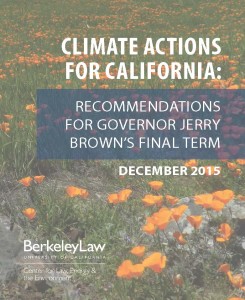 But more progress will be needed to meet the state’s much more aggressive mid-century goals of reducing emissions 80 percent over 1990 levels. The state will need both to build on existing programs and to address new areas that are key to decarbonizing the state’s economy, such as natural resources, water and land use.
But more progress will be needed to meet the state’s much more aggressive mid-century goals of reducing emissions 80 percent over 1990 levels. The state will need both to build on existing programs and to address new areas that are key to decarbonizing the state’s economy, such as natural resources, water and land use.
With just over three years remaining in Governor Brown’s final term, Berkeley Law’s Center for Law, Energy and the Environment (CLEE) is today releasing the new report “Climate Actions For California: Recommendations for Governor Jerry Brown’s Final Term.” The report details immediate steps that administration leaders, environmental and energy advocates, and other stakeholders can take to achieve additional short-term successes and create a foundation for long-term progress that endures beyond the administration.
“Climate Actions for California” contains recommendations based on interviews and a convening with Brown Administration officials, agency leaders, philanthropic representatives, and environmental experts.
Among the key recommended solutions:
- A state data platform to better share existing data and collect new data on pressing environmental challenges, particularly on water management and renewable energy planning;
- Improved inter-agency coordination on climate actions, particularly on demonstration projects to reduce emissions that can quickly scale statewide and for collaborating on efforts with new sources of funding;
- More collaborative regional conservation planning to facilitate advance mitigation for new projects and smart development going forward, among other benefits; and
- Enhanced transportation and land use planning that achieves greater co-benefits on water management and resource conservation.
The report provides more detail on these and other recommendations and also summarizes the key challenges that many of the experts we consulted identified, as well as possible next steps and partnerships. Ultimately, these actions could help Governor Brown build on an already-successful climate legacy and ensure that the progress to date continues, not just in California but now across the globe in a post-Paris world.
After two decades of fruitless UN climate gatherings, I finally attended my first one last week and clearly must have broken the stalemate. Because international negotiators now have a voluntary global commitment [PDF] to keep world temperature rise to possibly less than two degrees centigrade by 2100. It’s a big victory for the climate movement and for particular world leaders, like President Obama.
Why the agreement now? It was a confluence of politics and economics. On the political front, momentum had been building to this conference with everyone from the Pope to Obama to climate activists laying the foundation for broad public support and international cooperation.
On the economic front, the conversation has changed dramatically since 2009’s failure in Copenhagen with the decreasing costs of certain energy technologies. Specifically, the rapid decline in the price of solar panels, the ongoing investment in and cost decreases of battery technologies (particularly for electric vehicles), and the glut of natural gas, which has helped make the transition away from coal easier.
So what does the agreement portend? As mentioned, it’s a voluntary commitment without any penalties for countries that fail to comply. Current business-as-usual policies place the world on about a 3-degree temperature rise by 2100. So we’ll still need major advancements to meet the terms of the agreement going forward.
As I blogged previously, the decision-makers that really matter weren’t at the Paris conference. After all, who decides if carbon is taxed or fossil fuel reserves stay in the ground? It’s the legislators and party bosses in various nations around the globe, and in some cases, it’s subnationals, including local governments with land use authority. Will they act? We’ll have to wait and see.
But one promising provision in the agreement is the commitment to greater transparency, in terms of each country’s progress meeting the goals. Peer pressure can be very effective, and in certain parts of the world, some countries won’t want to be seen as lagging by their neighbors on the climate fight.
So between that peer pressure, and the continued determination of leading climate countries and states like Germany, Norway, and California that is pushing the price declines of clean technology, we have some reason to hope. Because as celebratory as the conversation has been around the Paris agreement, that is still the position the world is in.
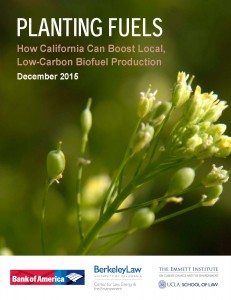 As I blogged earlier this month, UC Berkeley and UCLA Law released a report on how to boost low-carbon biofuels in California. To learn more about the report and its recommendations, please join us for a webinar today from 11am to noon. Speakers will include:
As I blogged earlier this month, UC Berkeley and UCLA Law released a report on how to boost low-carbon biofuels in California. To learn more about the report and its recommendations, please join us for a webinar today from 11am to noon. Speakers will include:
- Tim Olsen, energy and fuels program manager at the California Energy Commission
- Lisa Mortenson, chief executive officer at Community Fuels
- Mary Solecki, western states advocate for Environmental Entrepreneurs
You can register via this site. Hope to “see” you there!
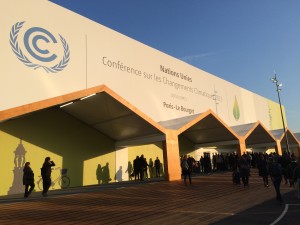 UC Berkeley’s news outlet published a Q&A with me on the important role that California is playing in the Paris negotiations. Here’s an excerpt:
UC Berkeley’s news outlet published a Q&A with me on the important role that California is playing in the Paris negotiations. Here’s an excerpt:
Could you elaborate on California’s leadership around climate change?
In 2006 California passed the first-in-the-nation law to limit our greenhouse gas emissions. Since then we’ve embarked on a suite of measures — investments, policies and programs — to bring down our carbon emissions. So far it’s been an interesting success story, and a great example for the international community, demonstrating that you can decarbonize and still increase economic growth.
We’re on pace to dramatically bolster our renewable energy supply. We have a very aggressive goal to get to 50 percent renewables by 2030, and we’re learning how to site these facilities better and to integrate the variable energy generated by solar and wind facilities. In terms of petroleum usage, California has 40 percent of the electric vehicle sales in the country, as well as strong sales of hybrid cars. We have some good state programs to encourage electric vehicle ownership.
On storage of surplus solar and wind energy, we have the only mandates in the country for utilities to buy a certain amount of energy storage. We’re seeing a huge growth in standalone batteries and other technologies, and we’re trying to build high-speed rail and to electrify more of our transportation. On energy efficiency, we have goals to double the efficiency of our existing buildings by 2030.
Since my expertise is on California’s climate efforts and not the international legal process, I may be overly biased toward the importance of what California is doing. But at the same time, the more time I spend at the Paris COP, the more I realize that all the technological and economic changes that are making climate mitigation achievable for so many countries is due to the leadership and market power of California.
Not that California gets all the credit, but it certainly couldn’t have happened without the state either.
Back in 1920s Paris, an unknown writer named Ernest Hemingway hung out in the local cafes with other aspiring artists. It was an odd group, featuring communists like Pablo Picasso, fascists like Ezra Pound, and right-wingers like Gertrude Stein. But they helped each other, promoting their work and ultimately producing a generation of famous artists captured in Hemingway’s posthumous memoirs A Moveable Feast. I now wonder if the Paris climate talks may serve a similar purpose — galvanizing a diverse network of leaders that can cumulatively promote their cause back home.
I’ve been attending the UN climate summit this week in part to answer the question of why this process matters. As I blogged last week, it’s hard not to feel skepticism about a process that has essentially yielded very little for two decades now. At the same time, the independent work of states and nations like California and Germany have completely altered the economics and technology of climate mitigation for the better — making the UN process feel even more pointless by comparison.
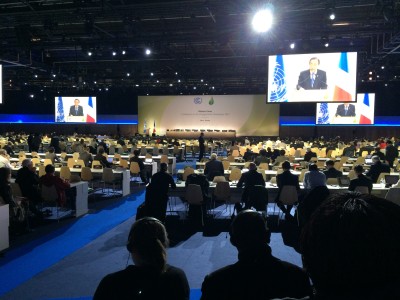
Global elected officials and leaders gather in Paris to listen to the COP 21 plenary.
So in that spirit, I’ve been asking people at the conference why they believe the international process is important. Most of them admit to me that they’re not quite sure how effective it will be, given past failures and the work that remains ahead around the globe. And of course, we still don’t have a final deal, and we don’t know how well Obama Administration lawyers can craft an enforceable executive agreement that won’t need to be ratified by the U.S. Senate.
But the people I’ve spoken with have made a number of important points that shouldn’t be overlooked. Without Paris and all the great expectations associated with it, we wouldn’t have had a number of major developments, such as:
- The papal encyclical casting climate change as a moral issue by an influential religious leader. Or at least the encyclical probably wouldn’t have gotten the coverage it did with the timing that it had, plus the corresponding bump in public acceptance of climate science that it seems to have spurred.
- The California-led Under 2 MOU effort to rally subnational climate leaders, which was explicitly aimed at motivating international negotiators in Paris. At a minimum, each of those subnationals will benefit from the agreement in many untold ways, given the information-sharing and political alliance it has forged.
- The mountain of media coverage and attention on the climate issue that the Paris talks have generated, leading to greater public awareness and possibly support for climate mitigation efforts.
- The network of influential elected officials primed to return to their home jurisdictions and promote the needed climate policies, as I alluded to above. That national and subnational implementation is where all the real work will be. While we don’t yet know how successful these climate leaders will be, at least they’ll be returning from Paris about as well-prepared as possible to take on their domestic challenges.
All of these developments point to the importance of having a singular, global event and discussion on climate change, which Paris has so far produced.
But in attending the conference, I’ve also seen first-hand the value of having such a global networking event. From “climate justice” activists to clean technology purveyors to big business leaders to nonprofit advocates to elected officials from every corner of the globe, these summits offer idea-sharing and networking that carry benefits well beyond the gathering, leading to collaboration and ideas with as-yet-undefined but likely benefits.
Of course, there’s still the risk that Paris fails to produce an agreement — or a good one. Or that so much hope is placed in the process that even with a seemingly good agreement we take our attention off the all-important implementation phase at the national and subnational level.
But so far it seems like this conference has little downside. The leading national and subnational players will still need to get the work done on climate back home, but Paris will provide some wind at their backs. And it may deflate the objections of some opponents, who could previously cite the lack of international action as a reason to do nothing.
So even when the conference pavilions come down, my guess is this climate feast at Paris will continue to move.
On Sunday the Sacramento Bee published my op-ed on how California can boost in-state production of low-carbon biofuels — not the wasteful Midwestern corn kind of biofuels. Here’s an excerpt:
[T]he state has not yet taken full advantage of the the ndiverse opportunities for low-carbon biofuel production from in-state biomass. While policies such as the state’s recently revised low-carbon fuel standard have put California on a leadership path in incorporating low-carbon biofuels into our transportation fuel mix, more federal and state action could ensure that California maximizes the environmental and economic potential of in-state innovation and production.
Federal and state leaders could:
- Provide greater support for in-state biofuel production, taking into account the full range of local biofuel carbon benefits and co-products, like biochar compost that can sequester carbon, and thin-film plastic to bed strawberries and tomatoes.
- Offer financial incentives for automakers and gas stations to allow and sell greater amounts of low-carbon biofuels and higher blend rates.
- Improve access to and financial support for in-state feedstock production, particularly on idled farmland and forestland to reduce wildfire risks.
Ultimately, California should set a goal of providing at least half of its low-carbon biofuel from in-state sources. Locally produced, low-carbon biofuel is an important bridge fuel to meet the state’s long-term climate goals, and it will benefit California’s environment and economy in the process.
You can read our new UC Berkeley / UCLA report on the subject here.
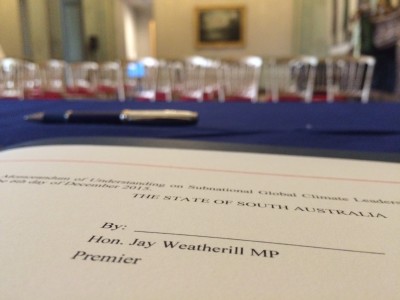 What started as a series of informal conversations about a year ago among Governor Brown, his senior staff, and a few world leaders, has turned into a veritable global movement. The “Under 2 MOU,” which I blogged about on Thursday, just bumped its total from 57 signatories last week to 80 today, with each representing a city, state or region around the world that is pledging to limit global warming to under 2 degrees by 2100. That signatory number is expected to increase further this week during the UN climate negotiations in Paris.
What started as a series of informal conversations about a year ago among Governor Brown, his senior staff, and a few world leaders, has turned into a veritable global movement. The “Under 2 MOU,” which I blogged about on Thursday, just bumped its total from 57 signatories last week to 80 today, with each representing a city, state or region around the world that is pledging to limit global warming to under 2 degrees by 2100. That signatory number is expected to increase further this week during the UN climate negotiations in Paris.
Governor Brown and the U.S. Ambassador to France, Jane Hartley (fresh off hosting President Obama at her residence), co-hosted a signing ceremony at the Ambassador’s Residence in Paris today, which I attended as part of Berkeley Law’s sponsorship of the luncheon that followed.
The signing ceremony included signatory states and regions from places like Brazil, Holland, and Australia, as well as cities closer to home like Austin and Oakland. The event featured a press conference with remarks from the ambassador, governor, and a representative from the German state of Baden-Württemberg, which launched this effort with California earlier this year. With 30 media representatives in attendance, the hope is that this effort will get strong publicity both in California and around the world to encourage international negotiators this week in Paris to strike a more aggressive climate agreement.

Governor Brown addresses the luncheon following the Under 2 MOU signing.
In the luncheon that followed for Brown Administration officials, California’s business delegation, and other environmental leaders and elected officials from around the globe, Governor Brown noted that even the “Under 2” goal by 2100 many not be enough. Scientists say that even with two degrees warming, it only gives humanity a 50% chance at averting catastrophic climate change. “I don’t know about you,” Brown said, “but how many of us would board an airplane if it only had a 50% chance of not crashing? I want to see that 50% chance of catastrophe become 0%.”
But short of changing the name to the less-catchy “Under 1.5” MOU, this subnational effort may be one of the best chances that climate advocates have for pushing strong, global action on climate change. Particularly with the international process getting bogged down by deference to the lowest common denominator, as Ted and Cara have blogged about, an agreement among more progressive subnationals could lay the foundation for strong global coordination, albeit at a different level than what negotiators will hopefully be finalizing this coming week.
Credit for this Under 2 MOU certainly goes to the governor and other elected officials, but also to his senior advisor (and Legal Planet guest-blogger) Ken Alex, who helped brainstorm the idea, as well as a dedicated staff from California’s “State Department” in the Brown Administration. With so many roadblocks on the U.S. national and international scene, it’s encouraging to see how much progress California is making at home and now globally.
 When we think of ways to reduce emissions from petroleum-based transportation fuels, electric vehicles get much of the headlines. Battery electric transportation certainly offers a viable, long-term alternative to petroleum fuels. But we’re still a few years away from an affordable, mass-market electric vehicle, and battery technology may be decades away, if ever, from being suitable for uses like long-haul trucking and aviation.
When we think of ways to reduce emissions from petroleum-based transportation fuels, electric vehicles get much of the headlines. Battery electric transportation certainly offers a viable, long-term alternative to petroleum fuels. But we’re still a few years away from an affordable, mass-market electric vehicle, and battery technology may be decades away, if ever, from being suitable for uses like long-haul trucking and aviation.
So what do we do in the meantime, if we hope to achieve California’s carbon reduction goals? Transportation, after all, is the single biggest source of greenhouse gas emissions in the state.
The response may in fact be growing all around us. Biofuels from agricultural sources like canola and corn, as well as algae, forest residue, and food waste, among others, can provide a low-carbon alternative to petroleum fuels, depending on its source and type. Certainly not all biofuels are environmentally beneficial, and one of the knocks on the federal Renewable Fuels Standard statute, with just-released new implementing rules from EPA announced on Monday, is that the law promotes biofuels that may actually be worse for the environment than petroleum fuels, given their production pathways and land use impacts.
But here in California, we have the opportunity to meet our climate goals while producing as much as half of our biofuels from low-carbon, in-state sources. To suggest policies that could boost this in-state production, UC Berkeley and UCLA Law are today releasing a new report “Planting Fuels: How California Can Boost Local, Low-Carbon Biofuel Production.” The report is the 16th in the two law schools’ Climate Change and Business Research Initiative, generously supported by Bank of America since 2009.
While California has a small but growing amount of biofuel production and consumption, federal and state leaders could do more to boost low-carbon, innovative biofuels. These leaders could:
- Provide greater support for in-state biofuel production, taking into account the full range of local biofuel carbon benefits and co-products, like biochar compost that can sequester carbon and thin-film plastic to bed strawberries and tomatoes;
- Offer financial incentives for automakers and gas stations to allow and sell greater amounts of low-carbon biofuels and higher blend rates; and
- Improve access to and financial support for in-state feedstock production, particularly on idled farmland and forest lands to reduce wildfire risks.
With these steps, California could power our cars, trucks and airplanes in a more environmentally beneficial manner, while boosting local economies in the process.
To learn more about the report and its recommendations, please join us for a webinar on December 14th from 11am to noon. Speakers will include:
- Tim Olsen, energy and fuels program manager at the California Energy Commission
- Lisa Mortenson, chief executive officer at Community Fuels
- Mary Solecki, western states advocate for Environmental Entrepreneurs
You can register via this site. We hope you can join for further discussion on this important topic.


